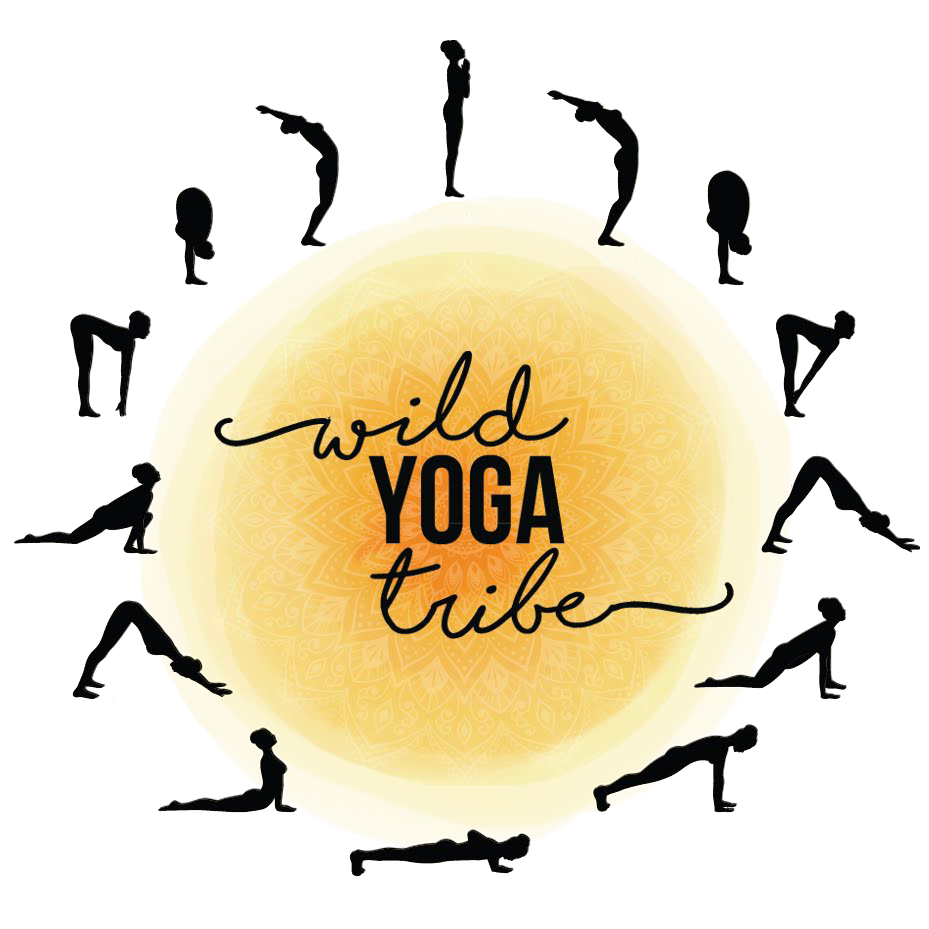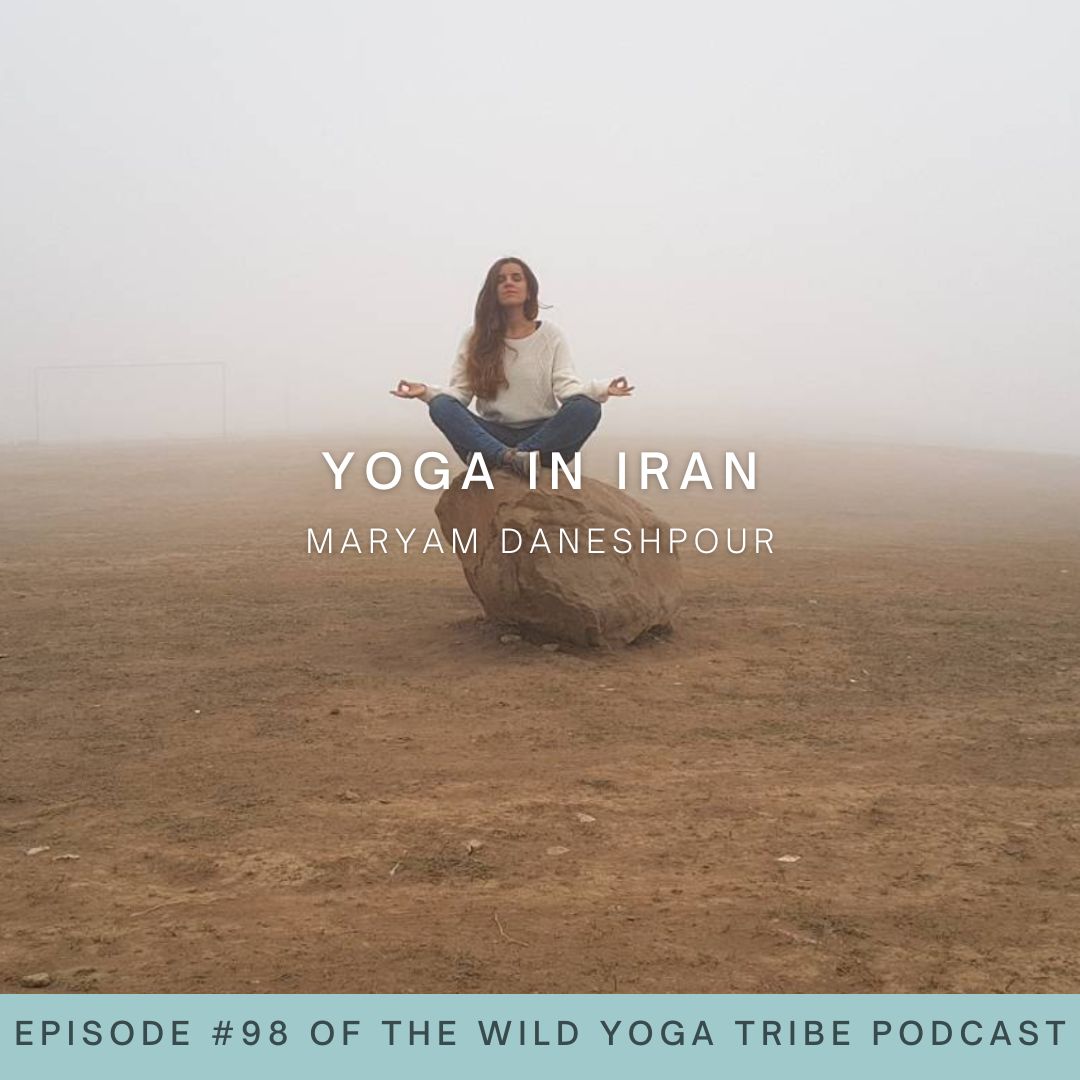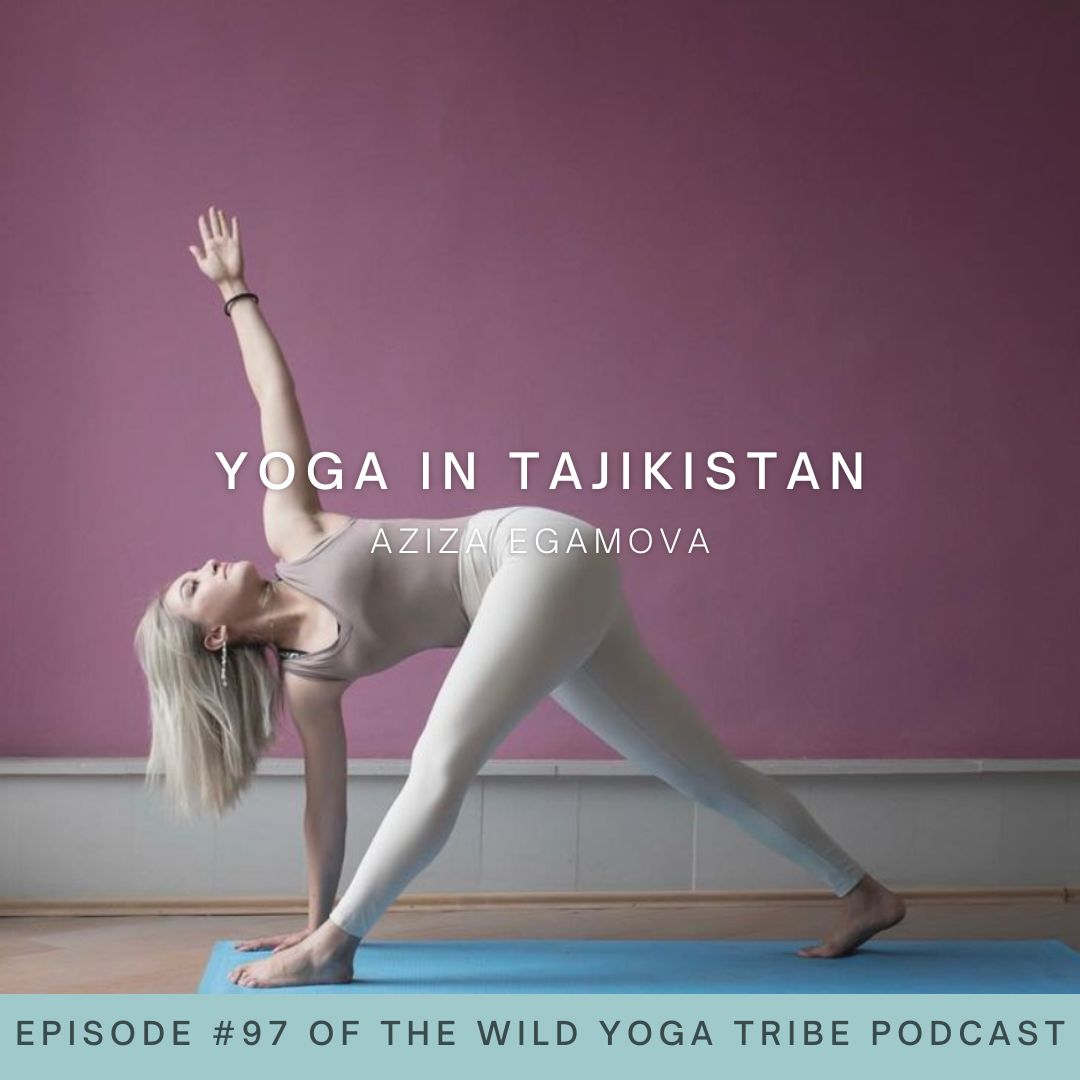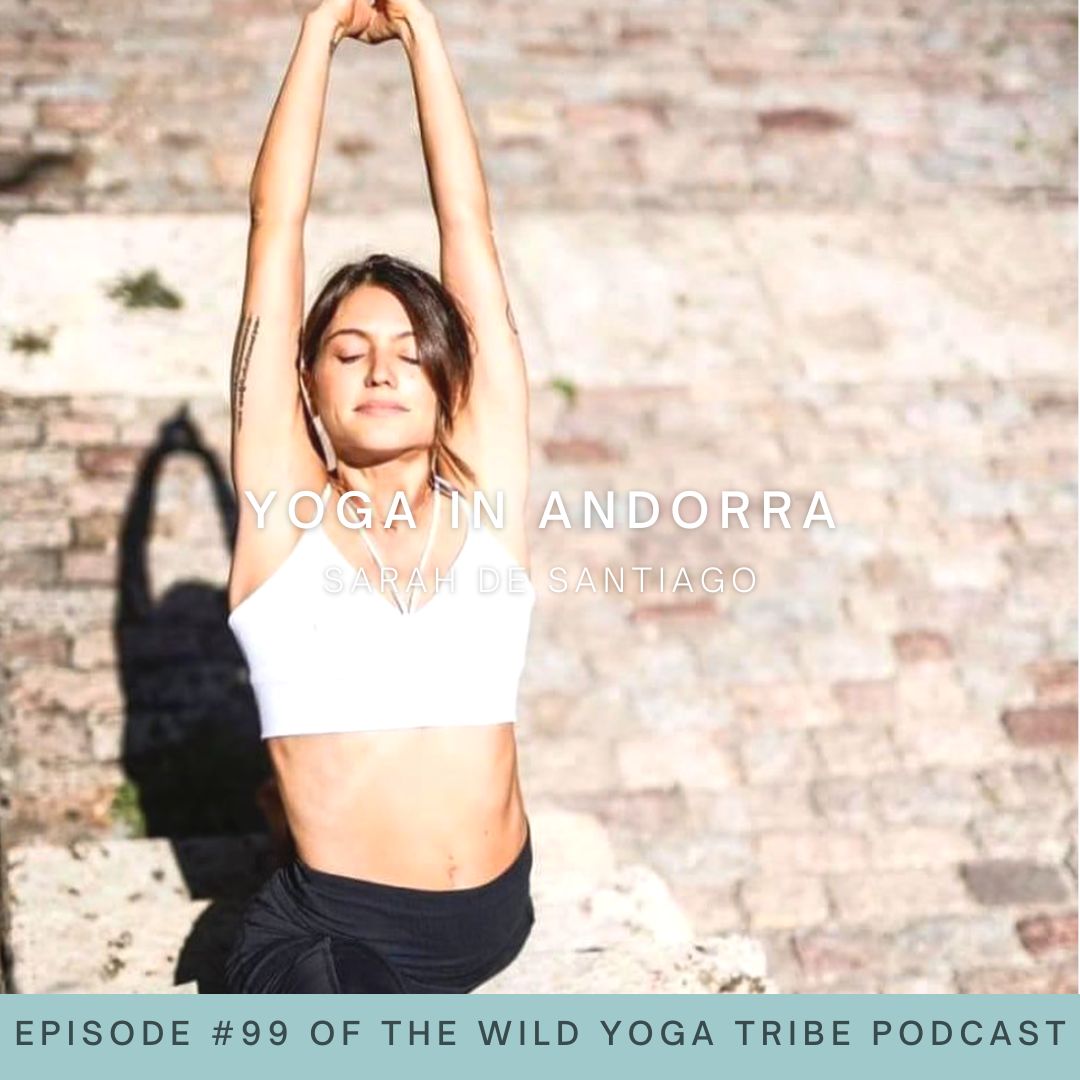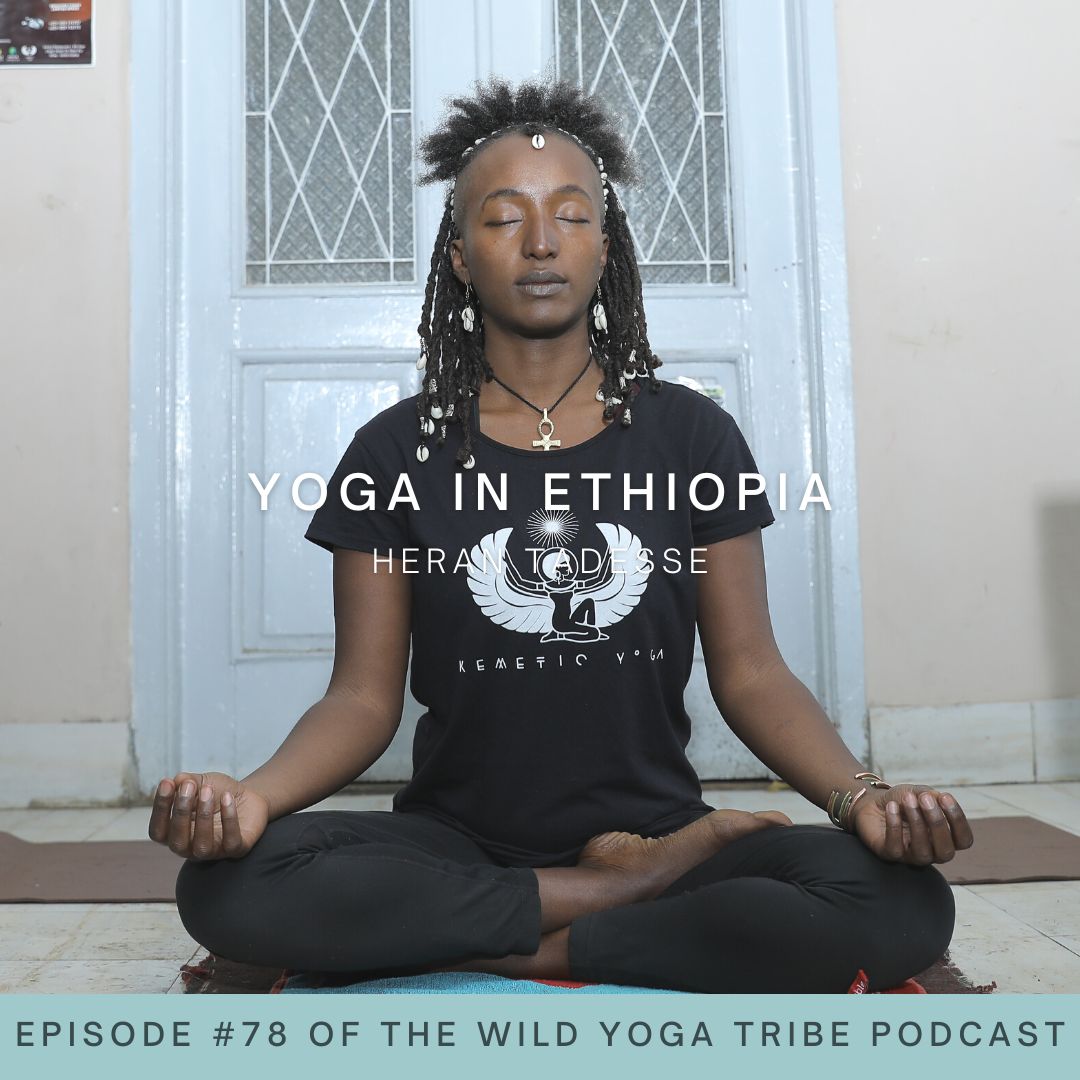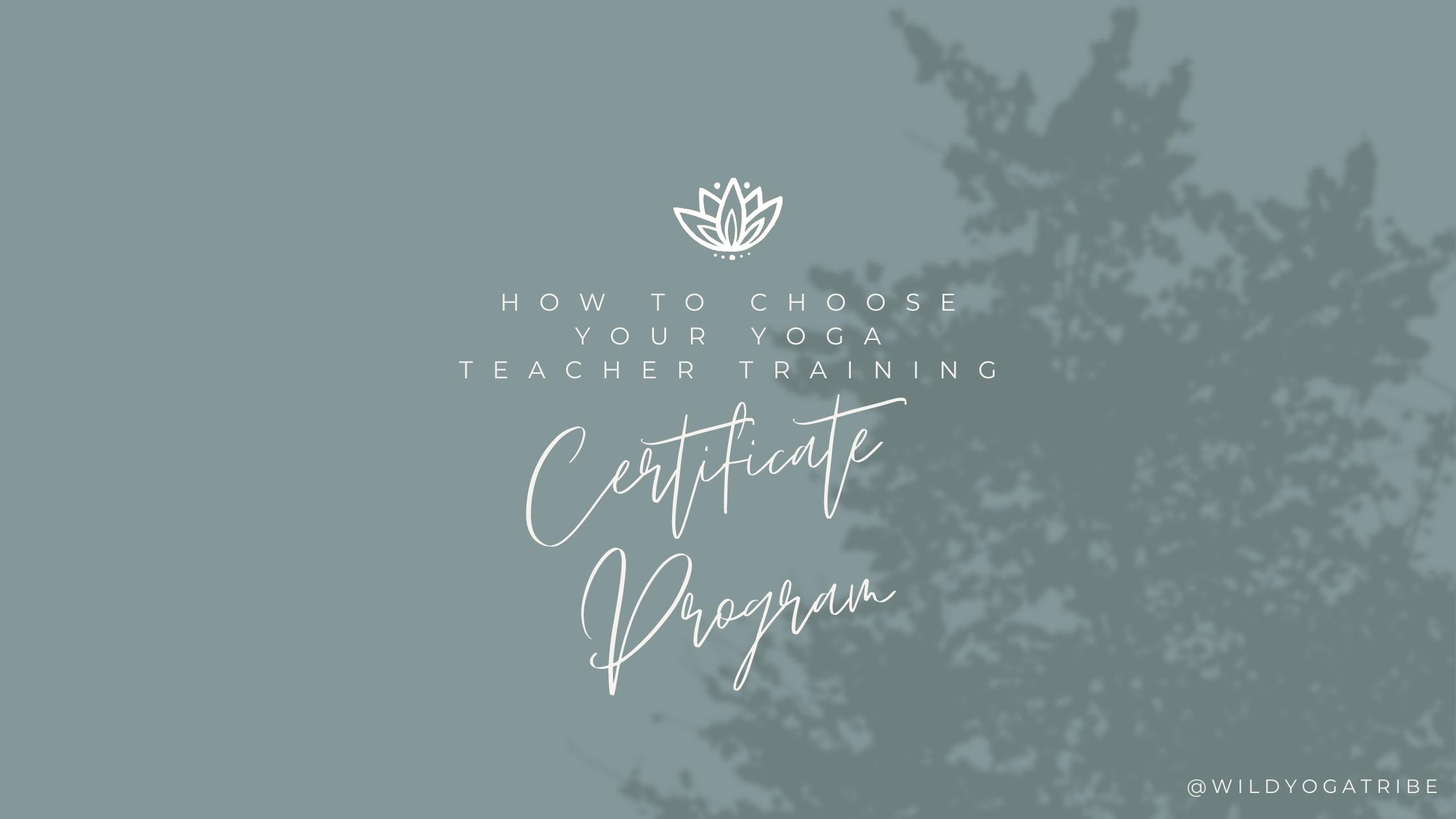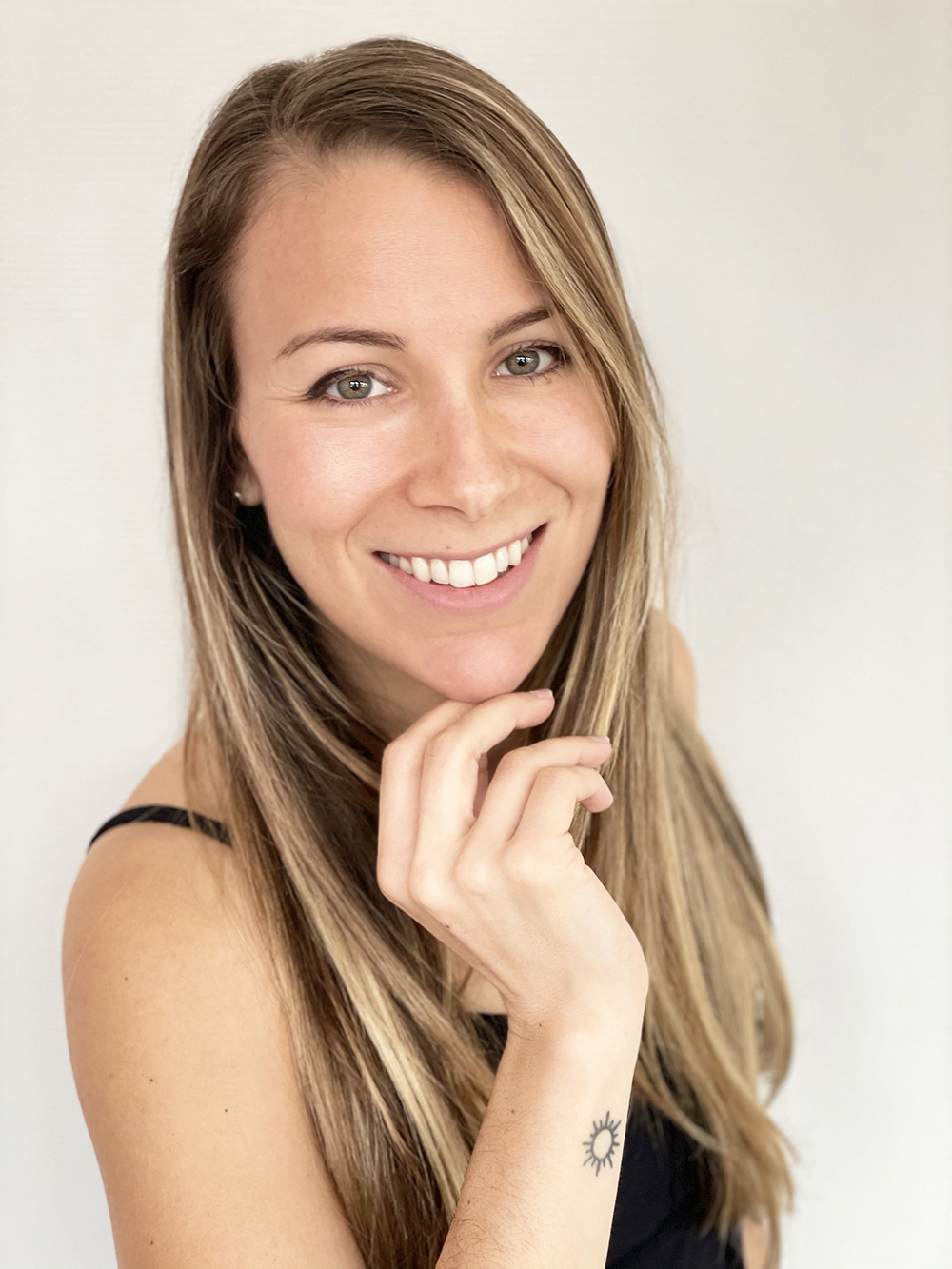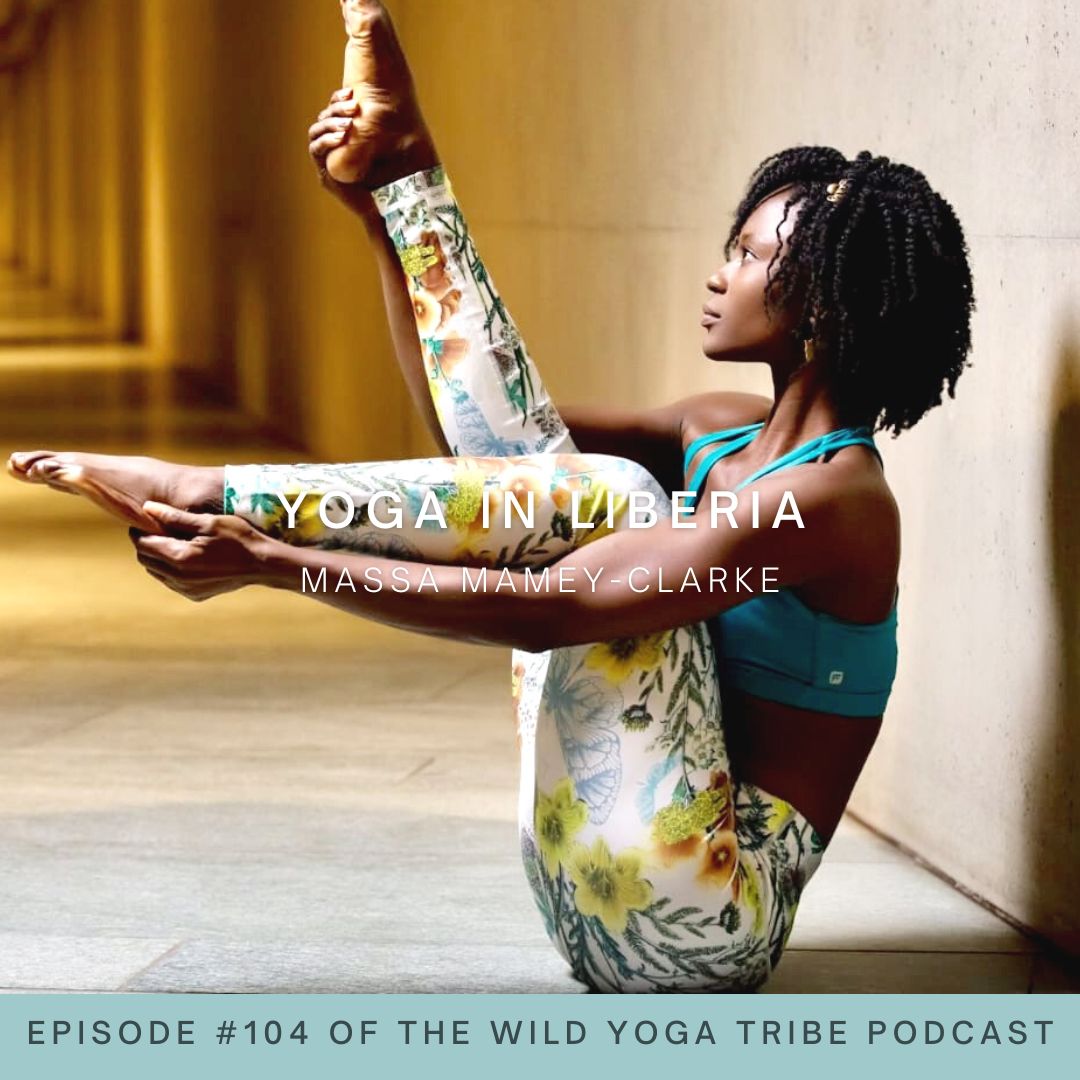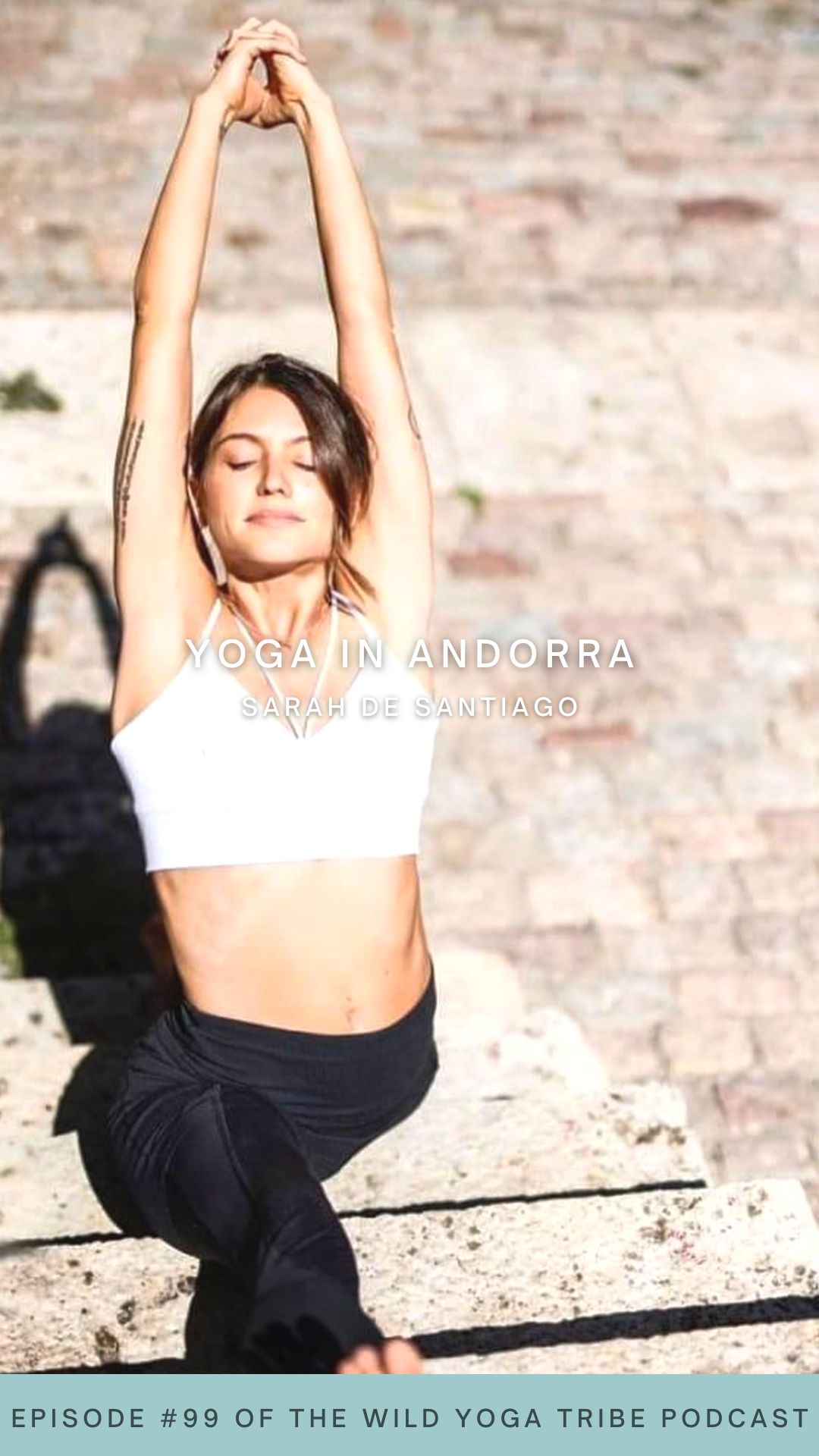
EPISODE #100 – YOGA ON NATIVE LANDS
Meet Kate Herrera Jenkins
Meet Kate Herrera Jenkins, a Native American yoga teacher whose practice is deeply rooted in the traditions of her heritage. This 100th podcast episode is a celebration and a heartfelt journey into the heart of yoga and native traditions, emphasizing the transformative potential of yoga in our lives and the importance of honoring our roots. Welcome to yoga on native lands!
Wild Yoga Tribe Podcast Episode #100 – Yoga is Ceremony – Yoga on Native Lands with Kate Herrera Jenkins
Welcome to Episode #100 of the Wild Yoga Tribe Podcast! My conversation with Kate Herrera Jenkins, a native yoga teacher who is from the Cochiti Pueblo, was gorgeous and glorious as we took a deep dive into the spiritual understanding of yoga as ceremony. We all want to have a place where we feel that we belong and where we empower each other through spirit— that’s something the whole world could benefit from, a tribe, tribal energy, the tribal mindset and SOUL set. If you’re looking to tune into a podcast episode that is all about yoga on native lands then this is the conversation for you.
Tell me more about Kate Herrera Jenkins
Kate Herrera Jenkins, a native yoga teacher who is from the Cochiti Pueblo, discovered her spiritual connection to yoga in 2007, as it was reminiscent of her experiences in the traditional Kiva on her reservation. Healing both physical injuries from running and emotional wounds from her past, she found renewal and confidence through hot yoga, completing various training programs. Former owner of Kiva Hot Yoga and Iron Tribe Fitness, she founded Native Strength Revolution, a community of Native American and First Nations yoga teachers and wellness leaders.
What to expect in the Yoga on Native Lands episode of the Wild Yoga Tribe Podcast
Let’s celebrate the 100th episode of the Wild Yoga Tribe podcast with Kate Herrera Jenkins, a Native American yoga teacher. The podcast episode is a heartfelt exploration of the intersections between yoga and native traditions.
Kate reveals how the magic truly happens when diverse individuals come together, bringing their own stories, songs, and prayers to the practice. These personal narratives breathe life into yoga’s ancient wisdom, creating a unique and beautiful learning experience.
The conversation is also deep dive into the concept of community, culture, and the universal need for a “tribe.” Kate and Lily discuss the significance of creating spaces where people from diverse backgrounds can come together, share, and learn. Kate speaks about her native heritage and the importance of welcoming others into her culture through feasts, where food and hospitality take center stage. Through Kate’s words, she truly conveys the power of yoga to foster connection, resilience, and healing in individuals and communities alike.
The 100th episode concludes with an invitation to support Native Strength Revolution, Kate’s non-profit organization that offers free yoga classes, an app, and various events. By participating in their offerings, you not only deepen your own practice but also contribute to building a community that celebrates diversity and cultural exchange.
The 100th podcast episode is a warm and inviting journey into the heart of yoga and native traditions. It seeks to remind us of the power of community, the importance of honoring our roots, and the transformative potential of yoga in our lives.
Favorite Quote From Kate Herrera Jenkins
“So that’s what yoga has been for me is being able to not be reactive even when it seems like you’re in a super challenging situation, to know that there still is choice, there’s still freedom somewhere, and it might not be from your human power, it’s going to be from something else, and I’m super grateful to be able to witness my young teachers and knowing more about their personal lives and the challenges that happen in a Native community or on a reservation or in an urban Native center how they’re working through that themselves, through the tools that they gain from yoga and that peace and the love and the forgiveness and the trust and the faith that comes along with the teachings that we learn instead of the unforgiveness and doubt and worry and fear. So shifting into that place of allowing spirit to be present so all those beautiful things can be there to help people on their journey. And then that’s what they teach to their students as well. So it’s such a cool waterfall, water flow of the life giving water of yoga. Water is life, yoga is life.”
What’s in the Yoga on Native
Lands episode?
Feel like skimming?
Yoga as ceremony
The meaning and usage of the word tribe
The mother daughter relationship in yoga
The tribal mindset and soulset
Water is life, yoga is life
Connect with Kate Herrera Jenkins to learn more about Yoga on Native Lands
Support the podcast:
https://www.patreon.com/wildyogatribe
Want more?
https://wildyogatribe.com/thepodcast/
Everything you need is just one click away! Check out all the resources here: https://linktr.ee/wildyogatribe
PODCAST TRANSCRIPTION
Read + Reflect + Respond
Wild Yoga Tribe Podcast Episode #100 – Yoga On Native Lands with Kate Herrera Jenkins Transcription
[00:00:00] Lily Allen-Duenas: Namaste family and welcome back to the wild yoga tribe podcast. I’m so excited today. This is a beautiful day. It is the 100th episode. This is quite a milestone. This podcast has been rolling strong, rocking and rolling for a hundred episodes.
Thank you so much for tuning in and listening to this special episode. I’m really excited about today. My guest is Kate Herrera Jenkins. She is a native yoga teacher who is from the Cochiti Pueblo. She first discovered her spiritual connection to yoga in 2007, as it was reminiscent of her experiences in Keva on her reservation.
Healing both physical injuries from running and emotional wounds from her past. Kate found renewal and confidence through Hot Yoga. She’s completed various yoga teacher training and teaches globally. She is the former owner of Kiva Hot Yoga and Iron Tribe Fitness, and has founded Native Strength Revolution.
It’s an amazing community of Native American and First Nations yoga teachers and wellness leaders. As you can tell, I am so excited to talk to her today. So thank you, Kate, so much for being here with me.
[00:01:13] Kate Herrera Jenkins: Hey Lily, I’m excited to be here. Thank you for having me.
How did yoga first come into your life?
[00:01:15] Lily Allen-Duenas: Awesome. Thank you. Just to dive in, to touch into your story. Can you tell us about how yoga first came into your life? What drew you to a life of yoga?
[00:01:28] Kate Herrera Jenkins: Yes I’ve always loved [00:01:30] movement and I’ve loved the traditions on my reservation. Primarily dancing and using that as our movement and spiritual practice. I’m also a long distance runner. I started running about 20 years ago, and still love it. I had a friend that said you’ve got to try this hot yoga, and I’m like, oh, that sounds so boring and not fun. She finally, after persuading me, got me into a hot yoga class in Atlanta. It was like 105 degrees and 40 percent humidity, I passed out before class even started.
She didn’t tell me it was 90 minutes long and yet something really happened in that class that once I surrendered to the heat. The situation that it was and realized I had no control, like it took me to a place of really my experience growing up on the Pueblo and in our ceremony, and something happened where I surrendered the control of my physical body in a way, and my mind, and really allowed spirit to help me in that moment, and I thought, Wow, this is so similar to how we have our experiences in our Kiva.
And this is so cool that I can do this and I’m not even home. I’m not even on my reservation. And anyone can experience that. And I was just so excited. So from that moment on, like I was just in love with the yoga and just loved how it healed my body, healed some of [00:03:00] my running injuries.
I was on fire for it, literally. With hot yoga and shortly after I started, I made the decision to become a teacher and then after that opened up my own studio so I could share that healing practice with everyone, in my community here in Alabama.
The progression from yoga studio owner to Native Strength Revolution
[00:03:17] Lily Allen-Duenas: Amazing. So you transitioned from owning Kiva Hot Yoga and Iron Tribe Fitness to transitioning to a full-time role through Native strength revolution. That’s a significant change. That’s huge. Can you walk us through your progression?
[00:03:34] Kate Herrera Jenkins: Yeah, so the vision for Native Strength Revolution I would say was given to me by a creator probably about 12 years ago. I had this vision all about hot yoga. It’s gotta be hot. That’s where I was at that point in my life. I thought I would create this 18 wheeler actually, that would be like a heated trailer and I could do yoga with people and drive. I’d get my CDL license and I’d drive it from Pueblo to Pueblo.
So my drive to Cochiti, Pueblo is one of the 19 Pueblos in New Mexico. They’re all somewhat close together. I was like, Oh, I could hit two or three Pueblos in one day and lead these yoga classes. That was the original vision and then as years went by, I owned the studio, and then we started leading teacher training. I said oh this is how we grow that vision because I’m only one person and to have a team of people, and eventually build this army [00:04:30] of healers, yoga teachers, and wellness leaders that we have, that’s the way.
So that’s really what brought us to the current place of where we are. Many things happened that just indicated the decision was the right time to sell the studio. I had a really enthusiastic buyer, which was amazing. My mom was in her last years here on earth. So I knew. My role was to be a full time daughter and caregiver with her.
The same with the gym that we owned in New Orleans as well, sold it around the same time. I was able to surrender those and allow my mom to have a beautiful send off from this earth; and then be able to have abundance within our organization and be able to step into leading at full time.
What is Native Strength Revolution?
[00:05:15] Lily Allen-Duenas: Beautiful. Yeah. That sounds like it was just very meant to be, right? As you said. It was your enthusiastic buyer and you sold both of the Iron Tribe Fitness and Kiva at the same time. So it’s just amazing when you step into flow and then you can see how things unfold. Yeah, that was for a reason.
So for our listeners, can you tell us all more about Native Strength Revolution? What’s your mission and what are you doing?
[00:05:42] Kate Herrera Jenkins: Yeah, so going back to that original vision, being able to lead yoga on my reservation would be amazing. People know me. There’s a trust there, yet even if I were to go to a neighboring indigenous community or Pueblo or a reservation they don’t necessarily know me. They [00:06:00] don’t know my story.
They might not show up to class. So I realized early on we really need to be able to have a way to equip people who already have a heart for yoga, who’ve already experienced healing from yoga and are on fire for yoga and wellness to be that leader in their community. So that’s what we started doing.
We started leading our own 200 hour teacher trainings. Starting at my studio here in Birmingham was the very first one and continuing to grow from there. And so also really knew going into it that these people, once they went through training, and I think this goes for really any yoga teacher, no matter where you are, you can feel isolated, especially as a studio owner.
If you’re maybe like one of the only ones in your area, you’re like, Oh my gosh, burnout is, can happen people just feeling like they’re the only ones that are in this mission can be discouraging. So we wanted to really create an alliance of the teachers who had been through our program.
So we created gatherings, whether they’re online or in person to really help support each other and continue to give each other Support. Yeah, sure, there’s continuing education and tools, but really give each other support and community so that we don’t feel alone when we’re in those situations, when we’re starting a new program on our reservation or in our community and maybe we don’t have all of the support of like tribal leaders or the community in the beginning but really giving for us as the lead team, giving that [00:07:30] encouragement to the new teachers or even existing teachers who might be experiencing challenges.
So we want to make sure that our front line our teachers are always fired up. And we want to do whatever that is to keep them fired up and keep them on their own path of healing as well and keep their cup filled as well so that they can do that for their community.
[00:07:51] Lily Allen-Duenas: Oh, that’s amazing. I love that you have this first line, you have this thriving beautiful and buoyant community, right? That’s just lifting each other up. And I really appreciate Kate, that Native Strength Revolution from what I’ve learned about it from you and from all your digital space is that it’s not like a one and done, do a yoga teacher training and then see ya.
I think a lot of training centers globally may have that kind of energy. It’s just a group moves through and then another group comes. But it seems like you’re really serving your teachers and building this community just past the training itself.
Building a community of native yoga teachers that goes past just the training
[00:08:26] Kate Herrera Jenkins: Absolutely. That is something that I felt like I did actually get from my training. I did go to Bikram’s training in 2009 and it wasn’t necessarily through the organization itself. But through my training class, like we bonded. To have that just checking in with each other, like you taught your first class yet? How did it go?
Just keeping each other supported and engaged in teaching yoga was super important for me as a young teacher. It’s super important to me still as someone who’s [00:09:00] been teaching yoga for 14 years. I think that’s important for all of us to have some kind of community that we can check in with and that we like what they’re doing and we want to learn how are you doing that and how is that working and being creative being, of course, always, honoring the roots of yoga, but also being creative and how we get the word out there and how we get people into our classes and how we can merge who we are, whether it’s as a native person or whatever your background is how we can merge our true whole self into our class as well is super important. I think for any yoga teacher we try to help people see that and do that. We don’t tell them, they have to discover that on their own, but we do our best to create a space for them to be able to do that.
Being a yoga teacher is creative, but also can be heavy
[00:09:46] Lily Allen-Duenas: Amazing work. So powerful, but also, as you said, the community that we all need as yoga teachers just to say Hey, how are you doing that? Oh, I’m teaching. Did you teach your first class? How did it go? Those check ins, but also the problem solving. Being a yoga teacher is…it’s such a creative thing to be. It’s a contract thing or a freelance thing and there can be a lot of struggles just in terms of negotiating a contract or even a student in the class having an issue you’ve never encountered before.
I have someone who has cystic fibrosis who comes, has anyone worked with that? Any recommendations? Like there, there are so many. Reasons for yoga teachers to lean on yoga teachers. Clearly something I’m passionate about. I just can’t stop talking to [00:10:30] yoga teachers and learning from them myself..
[00:10:32] Kate Herrera Jenkins: And, no, yeah, and it can become heavy no matter who you’re working with. A lot of our teachers do work in the recovery field. They will go to recovery centers or recovery homes and teach classes and they, just as many of us do, get so invested in our students and just see such beautiful progress and.
Really like we pour more into them because we see them pouring more into themselves, right? Then it can get so discouraging when someone relapses or when somebody dies from an overdose. So it’s like to see these things happen with my teachers. I always have an open door where people can just talk it out because it can become heavy no matter who you’re dealing with. I think it’s important for our teachers to have that space for sure. Because they’re doing great things, and it can become heavy, and we want to make sure we can help them become light and come back to their light as well through it all.
How is yoga impacting native communities?
[00:11:34] Lily Allen-Duenas: That was really well said, because yeah, the darkness is there. Every person is a bright light, but just all the causes and conditions, circumstances, challenges, it can dim, and if we can’t find our light. Sometimes it takes another light, to light that flame again, and tap in. Or put it right next to us and just make it stronger, but is there something about yoga? I feel like we’ve been talking [00:12:00] about it for sure, but around it, is there something that you’ve witnessed? Maybe it’s a specific example, or maybe it’s just a generalization of how yoga is impacting native communities?
[00:12:14] Kate Herrera Jenkins: Yeah. And this is for a long time because I was one of the only native yogis that I knew. I felt like every time I stepped onto my mat, it was ceremony. So it was this time of surrender. It was this time of, Oh my gosh, I’m so weak and really calling on my higher power, calling on God. Oh yeah, I can not do this anymore.
I can’t hold this anymore. I can’t, whether it’s, a pose or whether it’s a certain season of life, and so when I started leading these trainings and hearing this without me saying it, hearing this come from the trainee’s mouth, it’s oh, I think this is a common theme for a lot of native yoga practitioners and trainees and teachers is that we do feel this connection because it is like a prayer. It is like ceremony and there is movement attached. So in my culture, it can only speak from my experience, but growing up, whether it’s a wedding or a funeral or a special spiritual ceremony, there’s a lot of movement involved.
It’s not like we sit in a seat or in a church, and simply just sit there and allow someone else to preside over everything. We are very active, the whole group is [00:13:30] very actively involved in celebrating the wedding. Or celebrating someone coming into womanhood or or mourning and grieving the loss of a loved one.
So we know that we have to be moving to allow that to really be able to leave our bodies, whether it’s celebration or whether it’s that grief. It’s something that’s, I think, come always very natural for a lot of Native folks who are maybe familiar with those ceremonies. So when we discovered yoga, it’s just oh yeah, like I’m going through it.
I think that’s what most yogis can experience too is oh man, I’m going through this thing, but the yoga just somehow helps like me process it in this whole way that talk therapy can’t, which talk therapy is amazing or other therapies, just can’t the way that, that movement and yoga truly can.
I think that’s something that really allows yoga to resonate with indigenous people, and what they’re used to and how they practice, and really merge in with their culture. It’s not so foreign. It’s not oh, this is from a different background. It’s oh no, man we do this.
This is from India. Yet we do yoga to help us Be able to connect to the creator, connect to spirit, and be able To move through whatever we need to move through in any area of our life.
[00:14:53] Lily Allen-Duenas: Yeah, a hundred percent. I completely agree, especially with what movement can unlock [00:15:00] and what it can release. What it can let go of, or what it can, how things can get through our bodies, through our energy fields, all those koshas, all the layers of who we are, and just get it out or bring it in or whatever needs to happen. I think it’s just very science backed. It’s very biological that mammals and all living creatures need movement. We live in a really static type of society. I feel like in the West, it just feels like we sit so much. It’s so much sitting these days. There’s a disconnection from…
Our mind to our bodies. I know that’s something everyone talks about: union is uniting the mind, the body and the spirit. But of course, the real union in yoga is the self to the universal, the single self to the cosmic. It does go beyond that. You’ve mentioned a few minutes ago, Kate, about honoring the roots of yoga. That’s something you try to do, but also how do you feel like you’re honoring the roots of your native culture in yoga as well. Is there something you’re trying to honor both simultaneously, or do they just feel interwoven? I just would love for you to expand a little bit if possible.
Honoring the roots of yoga and honoring the roots of native traditions
[00:16:15] Kate Herrera Jenkins: Yeah, I think each of our teachers has a different experience and I’m super grateful for our training. We actually have interviews for our training because we want to make sure we have a really great group and people [00:16:30] that are ready. I always tell people when they’re interested in our training program that this training program is 200 an hour.
We really do want to make sure that we get all the philosophy, and history to make sure that you really know where yoga comes from. I think that’s any yoga teacher, right? There’s certain standards that Yoga Alliance would like us to have in those curricula. So I tell them that this is pretty vanilla training, if you look at the curriculum. It’s no different than any other yoga training you’re going to see, yet the indigeneity comes in the group of people that gather together, so within each training, it’s so different. Because they bring in their own stories when we start to talk about yamas and niyamas. They start to bring in their own lessons that were passed down in their culture, or someone will bring in a beautiful song that reminds them of something that we’re moving through within the lessons or within the sutras, say or the Bhagavad Gita oh, this is something that’s so similar.
This prayer is so similar. This is something that is part of the song here that I’d love to share. It always has a drum available and it’s such a beautiful thing. How it happens so naturally when someone feels comfortable in the group or that these songs come out and these prayers come out.
The curriculum, It’s all what, most of us yoga teachers learn as far as the history and philosophy of yoga. Yet it’s really bringing in oh this is how we’ve been honoring this in my [00:18:00] culture. That’s going to be part of their teaching journey. I’m probably not going to take that because it’s not necessarily my history or my upbringing or my story, yet it’s such a beautiful thing to receive.
Oh my goodness. To be able to lead these training, but truly like the training are helping lead when they bring these beautiful elements that help us connect. What’s so cool too, is there’s a lot of folks who have not been connected to their traditions through their family for whatever reason. It’s a time for them to be filled with these things. To really see the possibility of oh, wow there are connections here that I can start to discover and explore myself.
It’s such a beautiful journey to be able to do that. It’s not like I’ll teach a teacher training and say, okay, here are these kleshas. This is the tradition that exactly goes with it, because here in the States. There’s 580 formations and there’s…I can’t remember how many, 300, maybe some First Nations up in Canada.
We’re all very different nations.
So knowing that, but also just with any yoga teacher, as we start to go onto this journey of self discovery and discovery of our relation to spirit and our relation to source or God being able to bring more of who we truly are, who we’ve been created to be within our teaching.
It’s a beautiful thing when we do gather in our training, and when [00:19:30] we speak about the Bhagavad Gita or or the sutras and really dive in. Into their history, say, this is a prayer that my grandmother taught me, or this is a song that we sing that reminds me of that.
It’s through that journey of them just bringing something out, and feeling safe to share that in the group is what starts to create. or really create a path for them to find their teaching voice and how they’re going to share with their community.
That’s what’s so beautiful about our training, and I’m super grateful for it that we’re receiving all of this history. These stories and these songs and these prayers that we don’t know because it’s not part of our culture. It’s not something that we’d necessarily share because again, these songs from somebody from another tribe, are their songs. It’s an honor to be able to listen and to receive those. It’s simply, we’re witnessing somebody on their teaching journey finding their craft, and finding the way that they’re going to deliver their yoga experience to their community.
[00:20:34] Lily Allen-Duenas: Wow. That is so powerful to have spaces where people from all different types of cultures and communities, all first nations and all indigenous. But so different, as you said, coming together and sharing. Because that’s something I’m so passionate about. Clearly the yoga teachers from every corner of the globe, and from other communities, and cultures coming together in conversation and learning and receiving wisdom, [00:21:00] insight, experiences from others. You’re doing that, like you have created an ecosystem where it’s happening. It’s incredible to me.
Being protective of her native community
[00:21:09] Kate Herrera Jenkins: It’s been pretty great. I’ve done my best to listen to the creator’s vision and the plan for this organization and that’s simply for me to listen, and to honor, be obedient, and do my best discerning. What space it is, and who needs to be in the space, or who’s ready for the space, and as far as co facilitators and all that, I’m super protective of my group for sure, of who comes in, and and I love the people that that are part of our team it’s been an amazing ride for sure.
How do you feel about the word “tribe?”
[00:21:39] Lily Allen-Duenas: Beautiful. I could feel myself as well, Kate, when I was saying you’ve created this amazing ecosystem, I could feel myself wanting to say you’ve this amazing tribe. Cause as you know, my podcast and this beautiful community I’ve created is called the wild yoga tribe. I know that also has been a word that has kind of faced a lot of criticism lately.
I was wondering if you could just speak a little bit about your feelings on the usage of tribe and in the wild yoga tribe capacity or in others.
[00:22:07] Kate Herrera Jenkins: Yeah, sure, and I completely speak for myself and my experience in tribes. I feel blessed to be part of the Cochiti Pueblo, which is one of the 586 tribes of the United States. And I’m also half Irish, and so being able to explore that lineage and the Celtic history and spirituality and mythology as [00:22:30] well, and to learn about all the tribes I and also to be doing different work in Africa and exploring all the tribes there, I feel like tribes is a very universal word. Over time, I think in the West, it’s something that people have lost touch with. In my belief from my background, from me being half of Native lineage and half white or Irish or however you want to say we all come from a tribe.
And I think in a way that’s what a lot of us are searching for is like, where is my tribe, and just like you mentioned there, like you created this tribe and Native Strength Revolution, some of the members actually do refer to it as hey, this is one of my tribes as well. And so it’s we all want to have a place where we feel like we belong where spirit is present, where we welcome in spirit in a similar way and that we’re able to empower each other through the spirit we’re able to just be a big support and yeah, for sure. I think that’s something that the whole world, if they don’t have it it definitely benefit from is a more tribal feel like it’s not about I’m living my best life, I’m doing this.
It’s like, how are we as a tribe living our best life? Because my actions do affect others, and my words and the way that I communicate and the way that I teach do affect others. So it is not about me. It is about the collective. When we have more of an even when we disagree, right?
So it’s like the [00:24:00] United States in a way is one big tribe with a lot of dissonance within the tribe. Yet how can we come back to a bit more of a tribal mindset and soul set, I guess you could say.
[00:24:12] Lily Allen-Duenas: Thank you so much, Kate, for sharing that. Yes, I think we all should come back more to the tribal mindset. I love how you also specified the soul set, because the mindset and the soul set, like the orientation of the being to the larger community, the greater good.
[00:24:29] Kate Herrera Jenkins: Yeah,
[00:24:30] Lily Allen-Duenas: We keep feeling like we’re one tree and we really forget that we are a forest.
[00:24:34] Kate Herrera Jenkins: over the
What is your personal definition of yoga?
[00:24:36] Lily Allen-Duenas: So, Kate, something I ask every single teacher who comes onto the podcast, and I feel like we have woven around it, and you’ve pretty much said it. But I’d love to still phrase the question to you, what is your personal definition of yoga?
[00:24:49] Kate Herrera Jenkins: I believe over the few years it’s really transitioned in a beautiful way and it’s like a young teacher, it was so much about the asana. I’m sure a lot of people say that. As we spend more time learning about yoga and receiving it, it becomes something different that’s present all the time, whether you’re on a mat or not. To me, that was very apparent in being a caregiver for my mom, and perhaps not having the time on the mat that I would, yet having the time in in meditation really prayer for her because when you’re a caregiver and their body is, what we see as [00:25:30] failing, yet their spirit is rising, it’s as a human with a small mind, we’re not God, it’s hard to figure it out.
So to be able to surrender. To be able to serve seva was a huge shift for me and my life of what yoga is and if anyone’s been. I think even from motherhood as well, or fatherhood, parenthood being a caregiver, whatever. Really brings us into a challenging yet beautiful space.
I know in the beginning, like it was all about, Oh, I’m working through this thing in my life and I’ve got to get to my mat. I’ve got to get to the hot room. And it’s truly about being able to allow spirit to be present. And at any time, whether you’re on the mat or not and help you work through that situation and hold you as you surrender.
Be the person that you need to be. Like for me, it was being the daughter that I needed to be. It was very humbling. experience in my life. So when I would see people traveling and all this yoga poses on the beach and all that kind of stuff. You’re like, Oh man, here I am in my mom’s bedroom, doing whatever needed to be done.
But ehoa, what a spiritually strengthening chapter of my life. I have no regrets. And I think that’s the power of yoga is being able to discern and to be able to be present to see what it’s time for now from moment to moment and to be able to move forward with no [00:27:00] regrets.
And if there is a history, if there is a past, being able to find peace in that and finding that God will use that for good eventually when it seems so ugly. So that’s what yoga has been for me is being able to not be reactive to even when it seems like you’re in a super challenging situation, to know that there, there still is choice, there’s still freedom somewhere, and it might not be from your human power, it’s going to be from something else, and I’m super grateful to be able to witness my young teachers and knowing more about their personal lives and the challenges that, that happen as a person lives in a Native community or on a reservation or in an urban Native center how they’re working through that themselves, through the tools that they gain from yoga and that peace and the love and the forgiveness and the trust and the faith that comes along with the teachings that we learn instead of the unforgiveness and doubt and worry and fear. So shifting into that place of allowing spirit to be present so all those beautiful things can be there to help people on their journey.
And then that’s what they teach to their students as well. So it’s such a cool waterfall, water flow of the life giving water of yoga. Water is life, yoga is life.
[00:28:19] Lily Allen-Duenas: I love the water metaphor and how I, there’s so much to unpack from a water metaphor too. I just, how water accepts whatever comes, you know, if a branch falls [00:28:30] in, if a rock falls in, it just accepts it. Or if it’s a big big branch or big tree, it flows around, creating a new path. it’s not reactive, it just responds slowly, with intention, and it just keeps on its path. Instead of react’s.
[00:28:48] Kate Herrera Jenkins: Exactly. It responds.
[00:28:51] Lily Allen-Duenas: , A question I do ask every guest on the podcast, so I say, all right, tell us more about your country. Tell us more about Uganda or tell us more about Lesotho. Then we kind of just talk about some things that are important or are of note for their culture, community, location, space. Would you mind telling us more about the Cochiti Pueblo or more about, you know, native land, native people, whatever arises in you, I’d love to have you speak on.
Native Feast Days – Be nourished and be the nourishers
[00:29:24] Kate Herrera Jenkins: Yeah. I can actually touch on a conversation I was having with one of my team members where we have the vision to actually put a conference on and he’s from the Southwest as well. He’s actually from the Hopi tribe and my tribe is from the Southwest, the Pueblo people, and so much of what we do and how we feel healed and connected to our group or community.
I was talking about this in the conference, I was like, dude, we gotta have some like just lunch that people have never experienced, some kind of lunch experience, because, you know, at a conference, you just like, oh, let me go get something quick, or and you’re trying to meet people, it’s just kind of never like a rich, time rich, just want to [00:30:00] all and talk to all, all the people there experience, it’s very rushed or just even forgotten. and In my experience of the Pueblo culture, there’s so much centered around food and we call it feasts. So we actually have feasts and to be able to prepare for days and days and days for these feasts. To welcome people into your home that you don’t even the lifeblood of a lot of our ceremonies that are open to all are these feast days.
We prepare with love. We serve the food with love. Even people, again, like I said, somehow people find their way in our home that we don’t know. So my grandmother, when I was young, we would say, grandma, like these people don’t even know you.
Very disrespectfully they fill the purses up with do you want us to be better at the door by turning people. She said, no, she said, this is why we do it. She said, we might be the only people that have nurtured them for months or years. We should and the giving and the welcoming and giving them the peace. And so that’s, within Pueblo culture, I think that’s a common way of welcoming people into that space and nurturing them.
Everyone is welcome and that we’re there to nurture them. For us in pueblo culture, like a lot of really really good And I mean, that’s bhakti, right? That’s a bhakti devoted to being able to serve food. A devotion to be able to to be served as well, to eat. To eat that food as well, and to be [00:31:30] in gratitude with it, and to be in communion with others.
That’s what I would say is huge if someone were to ever visit one of the pueblos.
All the feast days are actually publicized, and on the internet, anywhere really, and so if you want to experience Pueblo culture I would say to go visit one of the Pueblos on their feast day, and like I said, that’s the thing, like, everyone’s home is open. So if you’re like, I don’t know anybody here! I would encourage you to knock on a door, just walk in and get some of the most amazing home cooking, beautiful southwest stews and chilies all that you’ve ever had. Be nourished because that’s what we do, that’s what do… to be the nourishers.
[00:32:10] Lily Allen-Duenas: Oh, that’s amazing. A beautiful invitation to extend for anyone who is.
[00:32:14] Kate Herrera Jenkins: Yes, anybody, yeah, message me or email me and come on and we’d love to have you as our guest for sure.
[00:32:20] Lily Allen-Duenas: Oh, that’s amazing. So Kate, I would also love for you to share too. How can we support you if our listeners totally have questions or want to accept your invitation? I will link your website NativeStrengthRevolution.org and your social media in the show notes as well as on my website wildyogatribe.com/yogaonnativelands. So let me know if there’s anything else you want linked or anything you want shared, but here too on the podcast, Kate, do you want to just share how can we support, how can we step up or how can we get involved?
How can we get involved and support Native Strength Revolution?
[00:32:55] Kate Herrera Jenkins: I think throughout the podcast, um, we would [00:33:00] love for you to join our classes. All of our classes are free. We have our app. There’s a link on our website to download our app or it’s just Native Strength Revolution if you search in the Apple store and Google find it there and join any of our classes.
Really think you’ll find something. Maybe a little bit unique, then you might be in another class. All of our teachers are just, have beautiful hearts and lead in their own way. They all are native teachers as well. Of course, we’d love donations, all of our programming as well. I have a retreat coming, a traditional, medicines healing retreat in Tulum, and that’s going to be by myself and a Mayan friend who is a healer down there, and those proceeds actually go to the organization as well, so we’d love to invite anyone to that.
Spots are filling up and we’re super excited about that retreat coming up. I think that’s how you could support for sure. We just love to meet anyone or receive messages from anyone. really.
[00:33:55] Lily Allen-Duenas: So Kate, thank you so much for being with me here today. This conversation has been truly a celebration, a ceremony, right? Of us coming together and sharing. I just say a big thank you from the bottom of my heart. Thanks for being here.
[00:34:09] Kate Herrera Jenkins: Awesome. We say Naycha. That’s our feminine way to say thank you and appreciate you so much. Thank you.
Wild Yoga Tribe Podcast Outro
[00:34:16] Lily Allen-Duenas: My conversation with Kate Herrera Jenkins, a native yoga teacher who is from the Cochiti Pueblo, was gorgeous and glorious as we took this deep dive into the [00:34:30] spiritual understanding of yoga as a ceremony. We all want to have a place where we feel that we belong and where we empower each other through spirit.
That’s something that the whole world could benefit from, a tribe, a tribal energy, a tribal mindset and soul-set. If you’re looking to tune into a podcast episode that’s all about yoga on native lands, then this is the conversation for you. Thank you for listening to the Wild Yoga Tribe podcast. Be well.
Copyright © 2023 Wild Yoga Tribe LLC. All rights reserved. Transcripts are generated using a combination of speech recognition software and human transcribers, and may contain errors. Kindly check the corresponding audio before quoting in print to ensure accuracy.
The Wild Yoga Tribe, LLC, owns the copyright in and to all content in and transcripts of the Wild Yoga Tribe podcasts, with all rights reserved, including right of publicity.
What’s Okay
You are welcome to share an excerpt from the episode transcript (up to 500 words but not more) in media articles (e.g., The New York Times), in a non-commercial article or blog post (e.g., Elephant Journal), and/or on a personal social media account for non-commercial purposes, provided that you include proper attribution and link back to the podcast URL. For complete transparency and clarity, media outlets with advertising models are also welcome to use excerpts from the transcript per the above.
What’s Not Okay
No one is authorized to copy any portion of the podcast content or use Lily Allen-Duenas’ name, image or likeness for any commercial purpose or use, including without limitation inclusion in any books, e-books, or on a commercial website or social media site (e.g., Instagram, Facebook, etc.) that offers or promotes your or another’s products or services. Of course, media outlets are permitted to use photos of Lily Allen-Duenas from her Media Kit page or can make written requests via email to receive her headshots folder.
